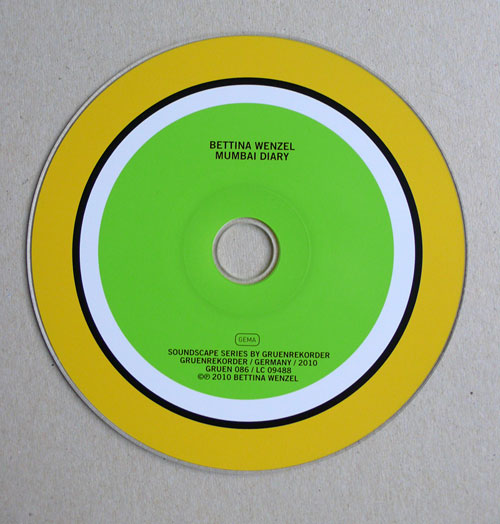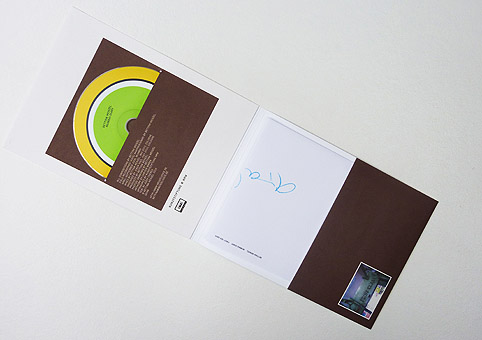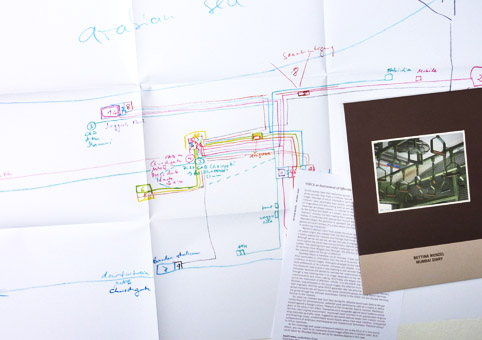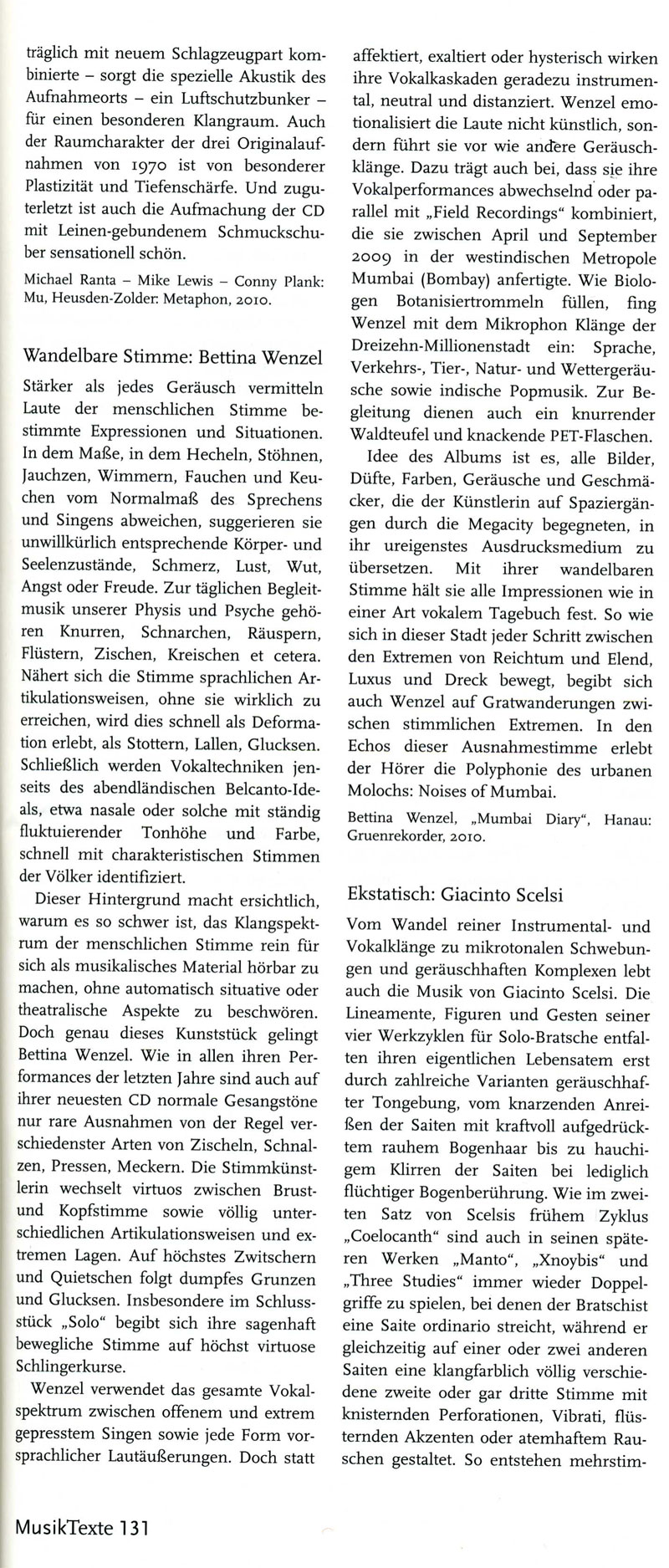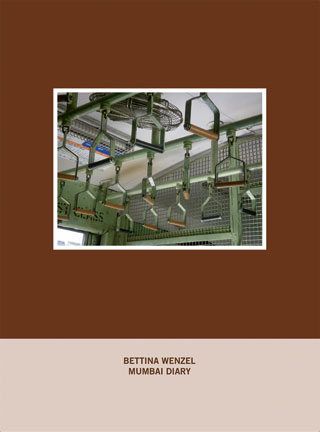
Mumbai Diary | Bettina Wenzel
FIELD RECORDINGS/VOICE/AKAPPAIKINNARI
Gruen 086 | Audio CD > [order]
MP3 & FLAC > [order]
1. electric cricket /// 4:58
2. crowded /// 3:47
3. the day before yesterday /// 4:10
4. long hours /// 8:02
5. back courtyard /// 5:59
6. both sides /// 2:51
7. scraping ice in june /// 5:10
8. downfall /// 4:13
9. solo /// 4:57
9 Tracks (44′10″)
CD (500 copies)
VOICE as Instrument of Affection
Sound diaries have their seductive appeal. Unlike written memoirs, sketches, cartoons and photo journals they share a common feature with film documentaries – the temporal sound-image. Deprived of visual information (and of predominance of sight), sound-image attracts listeners’ ears, penetrates their bodies, permeates through their minds, initiating the process of imagination and articulating lived as well as imagined experiences. No escape; intrusive meanings are always present. In contrast to moving images that reduce space and vision to the surface and depth of a screen, sound-images are capable of not only extending the listeners’ universe but also making them aware of and signifying the impulses within their bodies. If combined with appropriate musical expression, as in the case of Bettina Wenzel’s Mumbai Diary, the ambition to represent the unique artistic intention in correlation with genius loci and intimacy of a place where one finds oneself in a particular moment succeeds in producing interaction.
Wenzel’s abstract voice finds proper structural support in the concrete soundscapes (of urban origin) she created from the field recordings during her artist residency in Mumbai; it bodily spaces the intervals and foldings that house voice as their natural constituent. Although we do not see her, we feel that she is singing with her entire body; it is the body which paints the vocal lines and pointillistic textures onto the surface of a sound time-crystal. The resulting form was neither composed nor improvised; it was created by affection. As we know (from Bergson and Deleuze), the affection is coupled with the body that offers the internal space for the act of affection.
Mumbai Diary is therefore not an itinerary, it does not provide listeners with any space-time coordinates or information from the life of its author. Rather it is a sound album, a collection of sound-images, thoroughly arranged by the memory as well as by the taste and style preferences of its compiler, composer and adapter in one person. She compiles out of the obsessive need to give a new meaning to the recorded fragments of her memory. She composes because she desires to manifest her relationships with the world and other people through a new meaning that is no longer dependent on the old codes and conventions of art communication and music making. And finally, she adapts the compiled and composed result to her instrument of affection – VOICE. It is the VOICE that brings into the memories of Mumbai, now embodied in the sound-images, the affection from outside – from the body of their originator. And the same VOICE generates later the affective response in the listeners, whose memories are not bound to the above mentioned genius loci. The VOICE becomes the guide through the unknown soundscape, thanks to the VOICE the soundscape becomes familiar to the listeners.
So, what can listeners hear (and feel) during the affective sound walk Bettina Wenzel invites them to? Unconventional, extended vocal performance used as a means to define herself against a foreign culture. Pleasure of the immediate need to vocalize. Barthesian grain of the voice in full effect. Expressive voice escapades against sound patterns alienated from their original environment. Improvised vocal comment to an appropriated religious song disturbed by traffic noise. Suggestive percussive textures woven from metallic sounds and breathing noises. Unidentifiable sound objects versus clear vocal intention. Unexpected juxtapositions of ambitious onomatopoeias and indeterminist formalisms. Potential stimuli to fictive narratives…
As the chronology and causal-consequent relations are no the focus of in this sound album, you can listen to its impressive sound-images-affections in random order. M.D. could stand for Mumbai Diary as well as for membra disjecta in this case.
Jozef Cseres, aesthetician of arts
September 2010
www.facebook.com/profile.php?id=553258571
mail: bettina@wenzelvoice.de
All COMPOSITIONS BY BETTINA WENZEL
FIELD RECORDINGS/ VOICE/ AKAPPAIKINNARI BY BETTINA WENZEL,
APRIL–SEPTEMBER 2009, MUMBAI
MIXED BY BETTINA WENZEL, MAI 2010, COLOGNE
MASTERED BY JOKER NIES, JULY 2010, COLOGNE
PRODUCED BY BETTINA WENZEL
PHOTOS/ DRAWINGS BY BETTINA WENZEL
Artwork BY CHRISTA MAREK
TEXT BY JOZEF CSERES
© Bettina Wenzel 2010
SPONSORED BY KUNSTSTIFTUNG NRW
Soundscape Series by Gruenrekorder
Gruenrekorder / Germany / 2010 / Gruen 086 / LC 09488
EAN 4050486032947 / GEMA
Annette Eckerle | Neue Zeitschrift für Musik
Bettina Wenzel ist Stimmkünstlerin und Komponistin. Das Material der Komponistin ist das Material der Stimmkünstlerin und umgekehrt. Ihre Ausbildung hat Bettina Wenzel von 1992 bis 2001 am Centre Artistique Roy Hart in Frankreich absolviert, nach der Methode des Stimmspezialisten Alfred Wolfsohn und dessen Schüler Roy Hart. Die Idee Wolfsohns von der totalen Entgrenzung der Stimme, womit in erster Linie ein Tonumfang gemeint ist, der jenseits der üblicherweise akzeptierten geschlechtsspezifischen Ausprägung liegt, benutzt Wenzel in ihrem Sinne für intermediale Performances, für Stimmen-Stücke, die inspiriert sind von den bewegten Bildern des Alltags, vom Sound einer Stadt, vom Klang einer Sprache. Wenzel betreibt im weitesten Sinne die Arbeit einer akustischen Kartografin der Gegenwart. Dass sie es dabei mit ständig in Bewegung befindlichen Grenzen zu tun hat, macht ihre Arbeiten wiederum auf wundersame Weise zu vitalen Momentaufnahmen, zu historischen Dokumenten, die dennoch nicht zu altern scheinen.
Die vorliegende CD Mumbai Diary trägt all diese Charakteristika in konzentrierter Form geborgen schon in ihrem Titel. Sechs Monate lang war Bettina Wenzel im Jahr 2009 als Stipendiatin der Kunststiftung NRW am Goethe-Institut in Mumbai, Indien. Dort sind neben den Vorarbeiten für die Mumbai-CD auch Performances entstanden wie black fan quartett für Stimme und vier Ventilatoren. Mumbai Diary nun ist akustisches Abbild und musikalische Reflexion der ersten zehn Tage, die Wenzel in der Megapolis Mumbai verbracht hat, ein Hör-Stück in neun Teilen, ein akustisches Wege-Netz des Viertels, in dem sich die Autorin aufhielt, ein akustisches Dokument ihrer Streifzüge.
Das erste Soundposter ist mit Electric Cricket überschrieben. Es ist ein Spiel mit klanglichen Identitäten. Die Quelle der kribbelig-knistrigen Soundkoloraturen ist nicht eindeutig identifizierbar. Eine Dekodierung des musikalischen Materials ist wohl auch nicht intendiert. Es geht Bettina Wenzel offenbar eher darum, dem Hörer das Gefühl zu vermitteln, dass eine Stadt eine Bühne ist, dass Geräusche kulturell geprägt und in dieser Prägung auch zu vermitteln respektive als Material zu interpretieren sind. Im weiteren Verlauf dieser Introduktion, deren Titel Electric Cricket poetischer Leitfaden und falsche Fährte zugleich zu sein scheint, implantiert Wenzel ihre sprachmusikalischen Koloraturen, die den Duktus indischer Kunstmusik ebenso reflektieren wie den fließenden Rhythmus der benutzten Geräusch-Environments. Im weiteren Verlauf dieser CD also wird der Hörer, geleitet von bildhaften Titeln wie Crowded, The day before Yesterday, Long Hours oder Scraping Ice in June, dem Stimmengewirr auf Mumbais Straßen begegnen, der perkussiven Musik, die eine kleine Prozession begleitet, oder auch den Klängen indischer Musikinstrumente und eben Wenzels Stimme, sprachlos-sprachmächtige Antworten formulierend auf den Mumbai-Sound.
Petr Ferenc | Český rozhlas
Betina Wenzel: Pohlednice z Bombaje
Nahrávání ruchů okolního světa je stejně staré jako nahrávání samo – možná jen o několik okamžiků mladší, uvědomíme-li si, že nejstarší známou nahrávkou je voskový váleček s písní Maruška měla jehňátko. Lovectví zvuků je nicméně disciplína rozšířená a pěstují ji takové popkulturní ikony, jako je Čtyřlístek, i legendy industriální hudby.
Okolní svět lze nahrávat a později zpracovávat všelijak. Někdo vytváří čistě dokumentární záznamy, jiný exotické zvukové pohlednice. Francisco López osvobozuje zvuk od veškerého kontextu a vydává snímky bez názvů a obrázků na obalech, takže posluchači nezbývá než opravdu pouze naslouchat. Christina Kubisch zase po městech provádí skupinky zájemců vybavených sluchátky zachycujícími elektromagnetické impulzy bezdrátových sítí, detektorů v nákupních centrech a podobně. Dán Jakob Kierkegaard nahrává subbasové podzemní dunění islandských gejzírů, Američan David Dunn snímá pouhým uchem neslyšnou činnost kůrovců.
Německá umělkyně Bettina Wenzel je především zpěvačka, její album Mumbai Diary nahrané v indické Bombaji je proto kombinací terénních nahrávek a bezeslovného zpěvu, připomínajícího občas projev Ivy Bittové. Větší část záznamů, do kterých Wenzel zpívá, je dosti pohlednicová a exotiku z nich lze poznat na sto honů. Jako by zpěvačka svým hlasem komentovala album fotek z výletu.
Posluchač, který má v oblibě rafinovanější, abstraktnější zacházení s field recordings, bude albem Mumbai Diary možná zklamán, stejně tak milovník zvukových dokumentů, kterého bude rušit Bettinin zpěv. Těch několik abstraktnějších míst, ve kterých se její hlas sejde s neokázalým záznamem, jehož původ nelze okamžitě určit, za poslech sice stojí, celkově je album na můj vkus ale poněkud málo zapeklité.
Dozvídám se z něj pouze to, že Bettina Wenzel měla hezký výlet.
Andreas Fellinger | freiStil
„Mumbai ist wie zwei Pole eines Magneten: anziehend und abstoßend zugleich“, erinnert sich die Kölner Vokalistin Bettina Wenzel an ihr halbes Jahr in der indischen 18-Millionen-Einwohner-Stadt, genauer in deren Stadtviertel Bandra. Die Kunststiftung Nordrhein-Westfalen und das Goethe-Institut hatten ihr dieses Arbeitsstipendium ermöglicht. Wenzel revanchiert sich für die Einladung mit einem akustischen Tagebuch. Einem Tagebuch, das allerdings nicht linear erzählt, sondern punktuelle Impressionen festhält, sie mit Fantasie dokumentiert, interpretiert und für vokale Assoziationen verwendet. So finden sich neben ihrer Stimmkunst diverse field recordings, von Straßenszenen, öffentlich gespielter Musik und verschiedenen Klangobjekten. Darüber und dazwischen regiert Wenzels einfühlsame, in aller Einfühlsamkeit prägnante Stimme, die sie ab und zu, aber ohne technische Hilfsmittel, ins Unkenntliche moduliert. Tja, und dann finden wir endliche wieder einmal ein Poster einer CD beigelegt, darauf sehen wir eine gezeichnete Skizze der ersten zehn Tage von Bettina Wenzel in Mumbai.
Aurelio Cianciotta | Neural
of city traffic. Glimpses of a background with exotic music and citations that emerge alienated from their original context reassemble during atonal passages into extended audio emergencies that include metallic sounds, squeaks, gloomy lullabies and sighs. In „Mumbai Diary“ Bettina Wenzel shares with us an intimate universe, a deliberately fragmented and „gibberish“ narration, characterized by a precise geographical connotation, yet still very personal in the eccentricity of musical forms, intentionally ever-changing and sharpened by the possibility of intrusive meanings that always lurk in the delicate interweaving of stylistic connections. Here are iterations that, despite the many recordings made by the artist, have been largely rebuilt in a home setting – Wenzel’s Indian apartment – as part of the search for a sound quality that in the „road catches“ was merely hinted at. Finally we arrive at an intense sound, with nasal voices in harmony with the equally loud and evocative sounds of the eastern metropolis.
Interview Bettina Wenzel | By Guillermo Escudero / LOOP
German vocal artist, composer and improviser sound artist Bettina Wenzel works in different fields like performances combining voice, video and objects. Furthermore vocal compositions only and as improviser and performer she has been through out Europe, USA, and India. On “Mumbai Diary”, her most recent audio work she has recorded a wide range of sounds that the city give: car engines, people talking and screaming, birds, religious chants, objects and of top of this Wenzel added her vocals works expressed by the different emotions she felt in relation with the sounds. A very deep work indeed.
www.gruenrekorder.de and www.wenzelvoice.de
Which relation has your vocals with the street sounds on „Mumbai Diary“?
“It’s not so easy to give an answer, because the relation is created in a very intuitive way. By listening to my Mumbai field recordings as manifestations of the outside world, I listen in same time to the sounds of my inside world. Mumbai city was basically an unknown surrounding for me, where I didn’t grow up or where I don’t live normally. That makes that the sounds I hear are sometimes remaining without cognitive explanation. For example the bird sound you can hear in ‚Mumbai Diary‘ is the sound of a bird I’ve never seen. But for me, the sounds that bird makes are more interesting than to know how it looks like. Because it confronts me to a new and fascinating world that makes me act and react. My vocal sounds are a kind of answer to what I hear. All vocal sounds are based on the emotions that I have at the moment I’m listening to the street sounds. They are recorded separately from the field recordings and consequently based on remembered emotions.”
Which was the criterion to choose the street sounds during your stay in Mumbai?
“I enjoy myself to be in a surrounding, where I can hear very spare and small sounds, getting my ears very sharpened, especially listening to noises coming from the street when I find myself inside a building. i made a lot of recordings of the city from inside my apartment, but those recording where not usable for the CD because they where to distant to represent the listening quality I had in reality. So I decided to produce some typical sounds inside of the apartment itself. I smashed empty plastic bottles – as I had to do every day – and recorded the sound, then added the vocal sound. Besides listening to small sounds I like to be overwhelmed by a big street sounds with high intensity as well. In Mumbai I could find and record those full and complex sounds during religious street feasts. Corresponding to this intense sound, I choose during the voice recording session a powerful nasal vocal sound and felt virtually being part of this joyful noise making street. In Mumbai diary you’ll find very in time and small sounds and very powerful sounds as well. The criterion was to give the most diversity of sounds; this diversity is corresponding diversity of the city.”
How the different places where you have been influenced your vocal works/performances?
“Everywhere I go, I go there with my body and my emotions. All sounds I listen to, provoke a reaction in my body and my mind. This reaction is in my case transformed into vocal sounds. most of the places I went in Mumbai did trigger those reactions in an very intense way. So I recorded the sounds of those places by remembering my emotion later on. In a next step, I recorded the voice in a studio by choosing how to respond to the different sounds from Mumbai places and their special characters. During my 6-month residency in Mumbai, I also developed a vocal performance piece using four fans called ‘black_fan_quartett.’ in many places -almost everywhere- even in trains; I could listen to sounds of fans. Their shapes. Age and speed where influencing the sound in many ways and inspired me using this diversity for a composition.”
Which is the vocal work challenge the most?
“I think, to get another idea of beauty. For me, vocal sounds have a special beauty- even the ‘broken’ ones. But only if they are related to an emotion and if that emotional power is then transformed into alternative vocal expression. The most challenging is to continue to search for this quality of voice beyond singing techniques or purely traditional criterions.” Guillermo Escudero / January 2011
Guillermo Escudero | LOOP
This is the work of German vocal artist, composer and improviser sound artist Bettina Wenzel which consists in nine pieces created while she was attending as an artist-in-residence in Mumbai, India in 2009. She has studied vocal techniques, contemporary dance and dancetherapy in Europe and has performed her vocal works in Europe, USA and South Asia. On top of the field recordings of street sounds, found objects and religious musical ceremonies Wenzel makes guttural and breathing noises, high tones but also there is space for vocals that reach silence. The vocal sounds are neither composed nor improvised, is the own language of an artist that takes its own risk in her avant-garde proposal.
Este es el trabajo de la artista vocal, compositora, improvisadora alemana, Bettina Wenzel que consiste en nueve piezas creadas durante su estadía como artista residente en Mumbai, India en 2009. Ella estudió técnicas vocales, danza contemporánea y danza terapéutica en Europa y se ha presentado en Estados Unidos, Europa y Asia. Encima de las grabaciones de campo con sonidos de la calle, objetos encontrados y música de ceremonias religiosas, Wenzel realiza ruidos guturales y de respiración, altos tonos pero también hay espacio para el silencio. Los sonidos vocales no son compuestos ni tampoco improvisados, sino que es el propio lenguaje de una artista que se la juega por propuestas arriesgadas y vanguardistas.
Brian Olewnick | Just outside
In which Wenzel deploys site recordings from Mumbai which are perfectly enjoyable, ranging from street sounds to musical ceremonies, but insists on threading them with her vocals which, generally speaking, are somewhere in Shelley Hirsch territory, admittedly not a destination I find very appealing. She’s good at what she does, her vocal pyrotechnics impressive I guess (sometimes sounding eerily like a shenai) but the question lingers: why? Why place oneself so prominently into the mix? What have you really added? I could imagine something more along the lines of Pisaro’s „Transparent City“ where the composer’s contributions are deferential to the recorded sounds, in this case, Wenzel’s vocals being just another element in the mix. But here, it’s far too much her, and what she does isn’t all that interesting. Where’s Ami Yoshida when you need her?
Oreshkin Sergey | maeror3.livejournal
Кто-то привозит из путешествий множество фотографий, чтобы потом рассматривать их и вспоминать о дивных (впрочем, тут кому как повезло) странствиях. Кто-то привозит мысли и впечатления, чтобы доверить их бумаге или клавиатуре компьютера. Немногие люди, воспринимающие окружающий мир скорее органами слуха, нежели зрения, привозят многочасовые аудиозаписи, сделанные ими на протяжении всего маршрута, чтобы потом, прослушивая их снова и снова, воссоздавать звуковую атмосферу далеких мест у себя дома.
Известная авангардными перфомансами немка Беттина Вензель записала в Индийском Мумбае шум заполненных суетливыми людьми городских улочек, тишину деревенского вечера, нарушаемую лишь шорохом листвы, голоса из хрипящих радиоприемников, пение уличных музыкантов и популярные мелодии индийского кино. Многим хватило бы и этого, чтобы создать еще один из многочисленных коллажей на тему «конкретной музыки», но немка пошла другим путем и решила стать частью зафиксированного ею мира. Для этого поверх оригинальных записей Вензель наложила звуковую дорожку со своим голосом, пытаясь попасть в настроение каждого конкретного момента и вписаться в его ауру, так сказать. К сожалению, лично мною этот оригинальный, чего уж там, эксперимент, помноженный на скрип и умеренный ритм непонятного и не обнаруженного на просторах Интернета инструмента или предмета с названием «Akappaikinnari», остался непонятым. Дело в том, что Беттина большую часть времени довольно неприятно изображает экстатический припадок, то склоняя на все лады какую-нибудь букву или звук, то старается имитировать традиционное пение (подражая актрисам из кинофильмов) и «голосовую» перкуссию, но больше всего это похоже на мелкие кусочки разорванной пленки с записью голоса «а капелла», которые потом склеили в произвольном порядке. Заикания, смешки, нотки сумасшествия, чириканье на птичьем языке, перепады настроения – «voice art», в отличие от оригинальных «полевых» записей по душе мне не пришелся. Хотя идея интересна – интеграция в оригинальную атмосферу, взаимодействие с ней и расширение пространства, в котором обитают повседневные звуки, новый взгляд на другую культуру, наконец. Можно, отбросив субъективность, признать это интересным.
Frans de Waard | VITAL WEEKLY
[…] The third release using voice is by Bettina Wenzel. She was in Mumbai where she did some field recordings and played some sounds. These are a quite alright, but it eludes me why she wanted to add her abstract use of the voice to these, other than perhaps that just the field recordings and played sounds aren’t the strongest in the world. But the addition of voice however adds an odd ball to these recordings, and doesn’t say much about Mumbai itself. Or maybe after a double CD and a DVD I am just a bit tired of abstract long voice material. Even then it would probably not be thumbs up, but not really down either. […]

